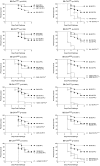Chromosome y regulates survival following murine coxsackievirus b3 infection
- PMID: 22384388
- PMCID: PMC3276194
- DOI: 10.1534/g3.111.001610
Chromosome y regulates survival following murine coxsackievirus b3 infection
Abstract
Coxsackievirus B3 (CVB3) contributes to the development of myocarditis, an inflammatory heart disease that predominates in males, and infection is a cause of unexpected death in young individuals. Although gonadal hormones contribute significantly to sex differences, sex chromosomes may also influence disease. Increasing evidence indicates that Chromosome Y (ChrY) genetic variants can impact biological functions unrelated to sexual differentiation. Using C57BL/6J (B6)-ChrY consomic mice, we show that genetic variation in ChrY has a direct effect on the survival of CVB3-infected animals. This effect is not due to potential Sry-mediated differences in prenatal testosterone exposure or to differences in adult testosterone levels. Furthermore, we show that ChrY polymorphism influences the percentage of natural killer T cells in B6-ChrY consomic strains but does not underlie CVB3-induced mortality. These data underscore the importance of investigating not only the hormonal regulation but also ChrY genetic regulation of cardiovascular disease and other male-dominant, sexually dimorphic diseases and phenotypes.
Keywords: heart disease; heterochromatin; sexual dimorphism.
Figures




Similar articles
-
Genetic variation in chromosome Y regulates susceptibility to influenza A virus infection.Proc Natl Acad Sci U S A. 2017 Mar 28;114(13):3491-3496. doi: 10.1073/pnas.1620889114. Epub 2017 Feb 27. Proc Natl Acad Sci U S A. 2017. PMID: 28242695 Free PMC article.
-
The Y chromosome as a regulatory element shaping immune cell transcriptomes and susceptibility to autoimmune disease.Genome Res. 2013 Sep;23(9):1474-85. doi: 10.1101/gr.156703.113. Epub 2013 Jun 25. Genome Res. 2013. PMID: 23800453 Free PMC article.
-
Sex chromosome complement contributes to sex differences in coxsackievirus B3 but not influenza A virus pathogenesis.Biol Sex Differ. 2011 Aug 1;2:8. doi: 10.1186/2042-6410-2-8. Biol Sex Differ. 2011. PMID: 21806829 Free PMC article.
-
Chromosome Y genetic variants: impact in animal models and on human disease.Physiol Genomics. 2015 Nov;47(11):525-37. doi: 10.1152/physiolgenomics.00074.2015. Epub 2015 Aug 18. Physiol Genomics. 2015. PMID: 26286457 Free PMC article. Review.
-
Age-Associated Changes in Estrogen Receptor Ratios Correlate with Increased Female Susceptibility to Coxsackievirus B3-Induced Myocarditis.Front Immunol. 2017 Nov 16;8:1585. doi: 10.3389/fimmu.2017.01585. eCollection 2017. Front Immunol. 2017. PMID: 29201031 Free PMC article. Review.
Cited by
-
Sex Differences in Expression of Pro-Inflammatory Markers and miRNAs in a Mouse Model of CVB3 Myocarditis.Int J Mol Sci. 2024 Sep 6;25(17):9666. doi: 10.3390/ijms25179666. Int J Mol Sci. 2024. PMID: 39273613 Free PMC article.
-
XX sex chromosome complement modulates immune responses to heat-killed Streptococcus pneumoniae immunization in a microbiome-dependent manner.Biol Sex Differ. 2024 Mar 14;15(1):21. doi: 10.1186/s13293-024-00597-0. Biol Sex Differ. 2024. PMID: 38486287 Free PMC article.
-
Myocarditis in Athletes: Risk Factors and Relationship with Strenuous Exercise.Sports Med. 2024 Mar;54(3):607-621. doi: 10.1007/s40279-023-01969-z. Epub 2023 Dec 11. Sports Med. 2024. PMID: 38079080 Review.
-
XX sex chromosome complement modulates immune responses to heat-killed Streptococcus pneumoniae immunization in a microbiome-dependent manner.Res Sq [Preprint]. 2023 Nov 2:rs.3.rs-3429829. doi: 10.21203/rs.3.rs-3429829/v1. Res Sq. 2023. Update in: Biol Sex Differ. 2024 Mar 14;15(1):21. doi: 10.1186/s13293-024-00597-0. PMID: 37961596 Free PMC article. Updated. Preprint.
-
Sex and gender differences in myocarditis and dilated cardiomyopathy: An update.Front Cardiovasc Med. 2023 Mar 2;10:1129348. doi: 10.3389/fcvm.2023.1129348. eCollection 2023. Front Cardiovasc Med. 2023. PMID: 36937911 Free PMC article. Review.
References
-
- Biddle F. G., Nishioka Y., 1988. Assays of testis development in the mouse distinguish three classes of domesticus-type Y chromosome. Genome 30: 870–878 - PubMed
-
- Clark A. M., Garland K. K., Russell L. D., 2000. Desert hedgehog (Dhh) gene is required in the mouse testis for formation of adult-type Leydig cells and normal development of peritubular cells and seminiferous tubules. Biol. Reprod. 63: 1825–1838 - PubMed
-
- Eicher E. M., Washburn L. L., 1986. Genetic control of primary sex determination in mice. Annu. Rev. Genet. 20: 327–360 - PubMed
Grants and funding
LinkOut - more resources
Full Text Sources
Molecular Biology Databases
